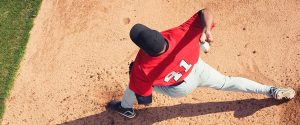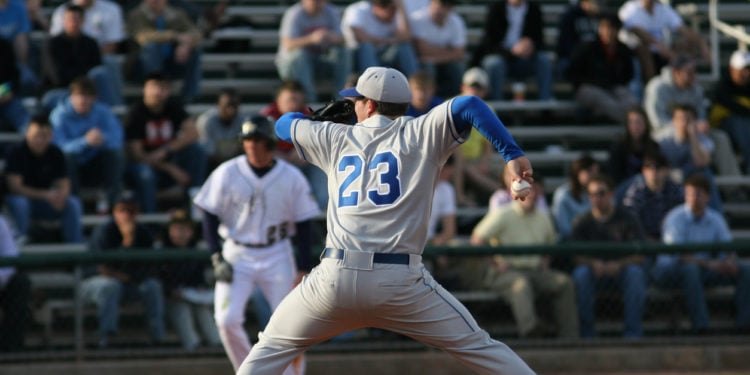Major League Baseball history was made in 1974. It wasn’t made by a World Series deciding play at the plate or even a record breaking event. History was made off the field when Tommy John, the then left-handed pitcher for the Los Angeles Dodgers, became the first person to have ulnar collateral ligament (UCL) reconstruction surgery by orthopedic surgeon Frank Jobe. This surgery eventually came to be known as Tommy John Surgery or T.J. as it is called in the sporting circles.
This article is not about the surgery itself but rather the career-extending effect that it had on Tommy John’s career and the competitive breath of life that it has given baseball players and throwers. From a mechanical vantage point, Tommy had to change his throwing mechanics, not just for rehabilitation purposes, but to also relieve the stress on his throwing arm, enabling him to continue his career with the 1976 season and beyond (to 1989!).
Research is inconclusive towards any one factor that contributes to the stress and eventual injury and tear of the UCL. The factors vary with point of views, including different angles with pitching mechanics, pitch count, innings pitched, type of pitch, velocity of pitch and rest between outings. Rotator cuff endurance and postural endurance can also be added to the list of factors.
Here we’ll explore range of motion and strength and conditioning needs of the baseball pitcher. From the biomechanical aspect of the throwing motion shows range of motion needs relative to the throwing arm. And additionally, where corrective exercise factors into this subject.
| OPPOSITE SIDE | SAME SIDE |
| Ankle Dorsiflexion | Hip ER |
| Hip IR | Hip Extension |
| Shoulder ER | |
| Shoulder IR | |
| Shoulder Flexion | |
| Shoulder Horizontal ADduction |
ER: External Rotation, IR: Internal Rotation

Although there remains no need to exceed norms, it is important to determine any lack in range of motion or comparable deficiencies in the respective joints.
Creating the ideal shoulder and elbow care plan for a throwing athlete means first starting with a comprehensive movement assessment. This may begin with a single assessment such as the Overhead Squat Assessment (OHSA). This assessment can sometimes be deceiving with the simplicity of application for a thrower. However, if the compensations are identified, the deficiencies in the previously listed joints can be addressed and integrated into a corrective exercise strategy at minimum.
For example, the OHSA identified the following compensations for a right-handed pitcher:
- Feet
- Left foot - Turns out
- Knees
- Valgus - Both knees
- Lumbo-Pelvic Hip Complex
- Excessive low back arch
- Excessive forward lean
- Shoulders
- Both arms fall forward
Any one or all of the compensations combined may have an effect on pitching mechanics and with the following reasons
- Opposite foot, knee and hip mechanics are needed for the lead, landing foot as the pitcher strides towards home plate.
- Low back arch and forward lean reflect a lack of strength in the hips and spine necessary for ideal posture to keep head, neck and shoulders in position.
- Arms falling forward may reflect a lack of shoulder flexion required to keep an efficient arm angle as the pitcher throws within the strike zone.
A fault in any one of these joints will have an influence on all other joints involved in the throwing motion.
Taking the same OHSA results a Corrective Exercise program or “Self Care” may have the following strategy:
- Inhibit: Roll
- Left Peroneals
- Adductors
- Lats
- Lengthen: Static Stretch
- Standing Calf
- Standing Adductor
- TRX Lat Stretch
- Activate: Strengthen
- Medial Calf
- Ball Bridge
- 4-Point Scaption
- Integrate:
- Lateral Tube Walking
- Alternating Forward Lunge to Balance and Overhead Press
The subsequent baseball conditioning plan may be progressed with displayed control and improved movement efficiency with a reassessment of the OHSA or any additional assessments appropriate for throwing. Other assessments may include, but are not limited to, the following:
- Dynamic
- OHSA
- OHSA with Heels Elevated
- Shoulder Flexion
- Shoulder ER
- Shoulder IR
- Trunk Rotation
- Goniometric
- Ankle Dorsi-flexion
- Hip ER
- Hip IR
- Hip Extension
- Shoulder Flexion
- Shoulder ER
- Shoulder IR
- Shoulder Adduction
Once Corrective Exercise is not the primary concern the athlete can progressed to a stabilization-based conditioning plan. For example:
- Foam Roll
- Calves
- Piriformis
- Static Stretch (30 sec. hold)
- Standing Calf
- Piriformis Stretch
- Lat Stretch
- Core
- Floor Bridge with March
- 4-Point Scaption
- Balance
- Single Leg RDL
- Reactive
- Lateral Jump Squat with Stabilization
- Resistance Training
- Squat to Overhead Press
- Single Arm Dumbbell (DB) Press on Ball
- Multiplanar Lunge with DB Reach
- Prone Ball Alternating DB Rows
- Standing Cobra
- Tricep Extensions with Tubing
- Cool Down
- Roll
- Lats
- TFL
- Quads
- Static Stretch
- Kneeling Hip Flexor Stretch with Overhead Reach
- Roll
The baseball pitcher specific program is multifaceted especially when it comes to their various needs. These needs include flexibility and optimal range of motion, balance, stabilization for impact, strength and power for speed of delivery, coordination, timing and postural endurance for multiple innings.
The baseball season can be as short as five months or go as long as year round. Maintaining all the physical assets for the sport requires constant monitoring and assessing of all joints. The more frequent the assessments the better the likelihood of preventng the development of compensations or, at the very least, maintenance of muscular symmetry.
Tommy John was able to continue playing baseball after what was previously considered a career ending injury. With post-surgery rehabilitation and a modified throw he was able to offset the stress that contributed to his UCL injury. Intervention is definitely possible with a few key factors:
- Coaching appropriate throwing techniques
- Managing rest and recovery
- Presenting a conditioning plan that considers both the needs of the individual and the demands of the sport.
References:
(2014). NASM’s essentials of corrective exercise training (1st ed Rev.). Burlington, MA: Jones & Barlett Learning.
(2018). NASM essentials of personal fitness training (6th ed.). Burlington, MA: Jones & Bartlett Learning.
(2019). NASM essentials of sports performance training (2nd ed.). Burlington, MA: Jones & Bartlett Learning.












